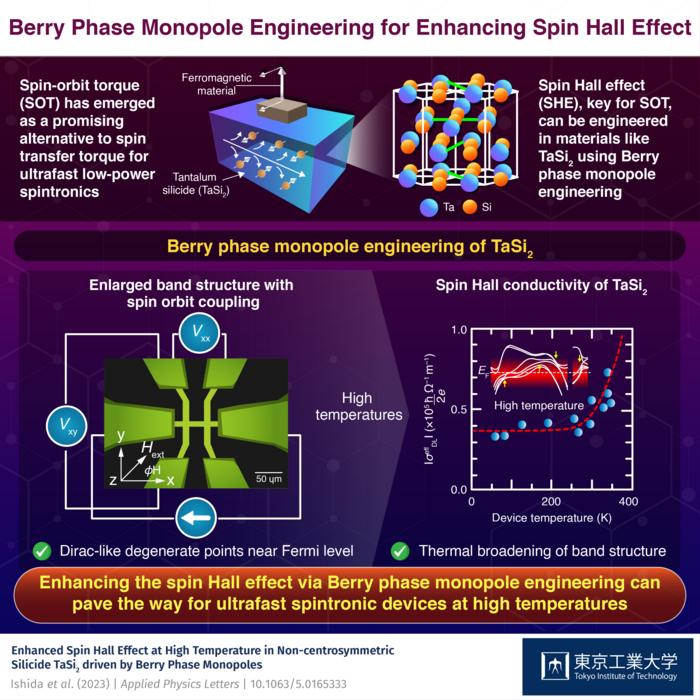Electronic devices known as spintronics use the spin of electrons - an intrinsic form of angular momentum that the electron possesses - to process data quickly and store it at a minimal cost.
 Enhancing The Spin Hall Effect via Berry Phase Monopole Engineering can Pave the Way for Ultrafast Spintronic Devices at High Temperatures. Image Credit: Tokyo Institute of Technology
Enhancing The Spin Hall Effect via Berry Phase Monopole Engineering can Pave the Way for Ultrafast Spintronic Devices at High Temperatures. Image Credit: Tokyo Institute of Technology
In this sense, a crucial phenomenon that makes ultrafast and low-power spintronic devices possible is spin-transfer torque. On the other hand, spin-orbit torque (SOT) has recently been proposed as a viable substitute for spin-transfer torque.
Numerous studies looking into the origin of SOT have revealed that the spin Hall effect (SHE), a phenomenon, is essential to achieving SOT in non-magnetic materials. Achieving large SHE in these materials requires the presence of a “Dirac band” structure, which is a particular configuration of electrons based on energy.
This is because the Berry phase, a quantum phase factor that causes the intrinsic SHE, has “hot spots” within the Dirac band structure. Thus, the key to designing the SHE is selecting materials with appropriate Berry phase hot spots.
Tantalum silicide (TaSi2) is a material of great interest in this context because its band structure has multiple Dirac points close to the Fermi level that make it suitable for Berry phase engineering practice. To illustrate this, a group of scientists recently examined the impact of Dirac band hot spots on the temperature dependence of SHE in TaSi2.
The researchers were led by Associate Professor Pham Nam Hai from the Department of Electrical and Electronic Engineering at Tokyo Institute of Technology (Tokyo Tech), in Japan.
Berry phase monopole engineering is an interesting avenue of research as it can give rise to efficient high-temperature SOT spintronic devices such as the magneto-resistive random-access memory.
Dr. Pham Nam Hai, Associate Professor, Department of Electrical and Electronic Engineering, Tokyo Institute of Technology
The team’s findings were published in the journal Applied Physics Letters.
The group found that TaSi2’s SOT efficiency nearly did not change between 62 and 288 K through a series of experiments, which is consistent with the behavior of traditional heavy metals. But as the temperature rose even higher, the SOT efficiency abruptly rose and almost doubled at 346 K. Furthermore, there was a comparable increase in the corresponding SHE.
Interestingly, this behaved very differently from traditional heavy metals and alloys. After additional investigation, the scientists concluded that Berry phase monopoles were responsible for the abrupt rise in SHE at high temperatures.
These results provide a strategy to enhance the SOT efficiency at high temperatures via Berry phase monopole engineering.
Dr. Pham Nam Hai, Associate Professor, Department of Electrical and Electronic Engineering, Tokyo Institute of Technology
In fact, the work opens up a new avenue for the development of high-temperature, ultrafast, low-power SOT spintronic devices and shows how Berry phase monopole engineering can be used to effectively use the SHE in non-magnetic materials.
Journal Reference:
Ishida, K., et al. (2023). Enhanced spin Hall effect at high temperature in non-centrosymmetric silicide TaSi2 driven by Berry phase monopoles. Applied Physics Letters. doi.org/10.1063/5.0165333.